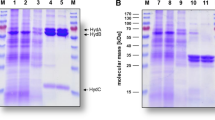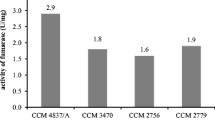Summary
The ability of several electron acceptors to promote the Gluconobacter oxydans catalyzed oxidation of glycerol was investigated. p-Benzoquinone was the most effective electron acceptor. The reaction rate obtained with p-benzoquinone was higher than the maximal rate with the natural electron acceptor, oxygen, in all the oxidation reactions tested.
Similar content being viewed by others
References
Adlercreutz, P. and Mattiasson, B. (1984) Appl. Microbiol. Biotechnol. 20, 296–302
Adlercreutz, P., Holst, O. and Mattiasson, B. (1985) Appl. Microbiol. Biotechnol. 22, 1–7
Alberti, B.N. and Klibanov, A.M. (1982) Enzyme Microb. Technol. 4, 47–49
Ameyama, M., Shinagawa, E., Matsushita, K. and Adachi, O. (1985) Agric. Biol. Chem. 49, 1001–1010
Daniel, R.M. (1970) Biochim. Biophys. Acta 216, 328–341
Holst, O., Enfors, S.O. and Mattiasson, B. (1982) Eur. J. Appl. Microbiol. Biotechnol. 14, 64–68
Author information
Authors and Affiliations
Rights and permissions
About this article
Cite this article
Adlercreutz, P. Use of artificial electron acceptors in oxidation reactions catalyzed by acetic acid bacteria. Biotechnol Tech 1, 103–108 (1987). https://doi.org/10.1007/BF00159330
Received:
Issue Date:
DOI: https://doi.org/10.1007/BF00159330




